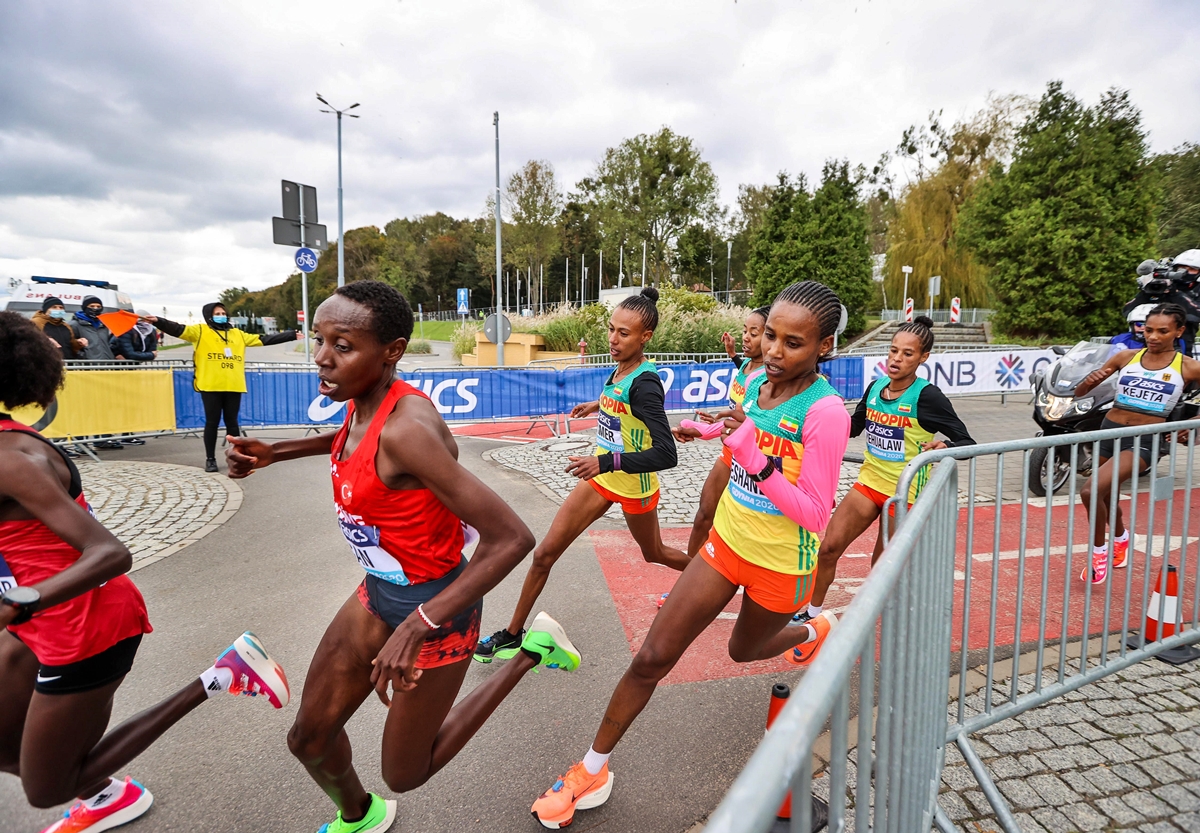

Featured
How Many Kilometers In A Half Marathon
Modified: January 22, 2024
Discover how many kilometers are in a half marathon. Find out everything you need to know about this featured distance in the world of running.
Introduction
Are you ready to take on the challenge of a half marathon? Whether you are a seasoned runner or a beginner looking to push your limits, participating in a half marathon can be a thrilling and rewarding experience. This article will guide you through the world of half marathons, providing you with essential information and tips to help you succeed in this grueling yet exhilarating event.
A half marathon is a road race that covers a distance of 13.1 miles or 21.0975 kilometers. It lies halfway between a 10K race and a full marathon, making it a popular choice for runners who want to up the ante without committing to the demanding training required for a full marathon. Half marathons attract participants of all fitness levels, from elite athletes aiming to set new records to casual runners seeking personal accomplishments.
Understanding the distance is crucial when preparing for a half marathon. While 13.1 miles might sound intimidating, breaking it down into manageable segments can help ease your nerves. Each mile can be viewed as a milestone, and with the right training and mindset, you will conquer every step of the way.
Training for a half marathon requires dedication and consistency. It’s important to gradually increase your mileage and incorporate different types of runs into your training regime, such as speed work, long runs, and recovery runs. A well-rounded training plan will not only improve your endurance but also enhance your speed and overall performance.
Nutrition plays a vital role in your half marathon journey. Fueling your body with the right nutrients before, during, and after your runs will optimize your energy levels and aid in recovery. A balanced diet rich in carbohydrates, proteins, and healthy fats, along with proper hydration, will help you reach your peak performance on race day.
Choosing the right gear is essential for a comfortable and injury-free run. Invest in a pair of well-fitting running shoes that provide adequate support and cushioning. Additionally, dress in breathable and moisture-wicking clothing to prevent chafing and keep you cool during your training sessions and the race itself.
Staying hydrated throughout your half marathon is crucial for maintaining optimal performance. Make sure to drink water or sports drinks at regular intervals during your runs to replenish the fluids you lose through sweating. Practice hydrating during your training to familiarize yourself with the best approach for race day.
What is a Half Marathon?
A half marathon is a long-distance road race that covers a distance of 13.1 miles or 21.0975 kilometers. It is a popular and challenging race distance that lies halfway between a 10K race (6.2 miles) and a full marathon (26.2 miles). The half marathon is a well-loved event in the running community, attracting participants of all fitness levels and backgrounds.
Why is it called a half marathon? The term “marathon” originates from the legendary story of Pheidippides, an ancient Greek soldier who ran from the city of Marathon to Athens to deliver a message of victory. The modern marathon race was established to commemorate this historic event. The half marathon, on the other hand, is half the distance of a full marathon, hence the name.
Participating in a half marathon requires preparation, commitment, and determination. It is a milestone for many runners who seek to challenge themselves and accomplish a significant feat. Some runners use the half marathon as a stepping stone to eventually tackle the coveted full marathon, while others prefer the shorter distance as a more achievable goal.
The race atmosphere of a half marathon is often vibrant and energetic. Participants gather at the starting line, filled with anticipation and excitement. The course is typically well-marked and manned by volunteers to provide assistance and support along the way. Spectators line the route, cheering on the runners and creating an encouraging and motivating environment.
Half marathons can be held on various terrains, including roads, trails, and even scenic routes. The diversity in course selection enables runners to choose races that cater to their preferences. Some half marathons take place in urban areas, winding through city streets, while others showcase natural landscapes and stunning scenery.
One of the appealing aspects of a half marathon is its inclusivity. Runners of all ages and abilities can participate, with many races offering different categories such as age groups or wheelchair divisions. This diversity fosters a sense of community and camaraderie among participants, as everyone comes together to celebrate their achievements and support one another.
While the half marathon distance requires considerable preparation, it is considered more manageable than a full marathon. The training period usually spans several months to gradually build up your mileage, allowing your body to adapt to the increased distance and intensity. With proper training, motivation, and support, completing a half marathon is within reach for many aspiring runners.
Understanding the Distance
The distance of a half marathon is 13.1 miles or 21.0975 kilometers. It may seem like a daunting distance, especially if you’re new to running or have only participated in shorter races. However, understanding the distance and breaking it down can help you mentally and physically prepare for the challenge ahead.
When you first think about running 13.1 miles, it can be overwhelming. But remember that a half marathon is a gradual progression from shorter distances like 5Ks or 10Ks. It’s a step up that allows you to push your limits and test your endurance.
As you train for a half marathon, it’s helpful to divide the distance into smaller segments. For example, you can break it down into ten 1.31-mile segments or thirteen 1-mile segments. Focusing on these smaller milestones during your training runs can make the overall distance feel more manageable.
During the race itself, you can mentally tackle the distance by setting goals at various checkpoints. Aim to reach the first 5K mark feeling strong and steady. Use the next few miles to settle into your rhythm and pace. Then, focus on reaching the halfway point with determination and positivity. As you approach the final 5K, give it your all and finish strong.
Understanding the distance also involves becoming familiar with the race course. Take the time to study the course map and elevation profile. Knowing where the hills and flat sections are can help you strategize your pace and conserve energy. Additionally, understanding the course layout allows you to mentally prepare for any challenging or monotonous stretches.
When training for a half marathon, gradually increasing your mileage is essential. Start with a base of comfortable running, gradually adding longer distances to build your endurance. Incorporate a mix of easy runs, tempo runs, long runs, and rest days into your training plan to allow for proper recovery.
As you build up your mileage, keep in mind that consistency and patience are key. Listen to your body and prioritize rest and recovery when needed. It’s better to take a rest day or scale back your training if you’re feeling fatigued or experiencing any discomfort to prevent injury.
Remember, each training run brings you closer to understanding and conquering the distance. With time and effort, you’ll become more comfortable with the idea of running a half marathon and confident in your ability to complete the challenge.
Training for a Half Marathon
Training for a half marathon is a journey that requires dedication, planning, and consistency. It’s important to have a structured training plan in place to gradually build your endurance, improve your running performance, and minimize the risk of injuries. Here are some key factors to consider when training for a half marathon.
First and foremost, establish a solid base of running. If you’re new to running, start by building your fitness level with a combination of walking and running. As your endurance improves, gradually increase the duration and intensity of your runs. If you’re an experienced runner, you can start with a higher mileage base.
Incorporate different types of runs into your training regimen. Long runs are crucial for building endurance and simulating the distance of a half marathon. Aim to complete at least one long run per week, gradually increasing the distance to cover the full 13.1 miles or beyond.
Speed work, such as intervals, tempo runs, and fartleks, will improve your running efficiency and help you develop a faster pace. These workouts involve alternating periods of high-intensity running with recovery periods, stimulating your cardiovascular system and increasing your speed.
Rest and recovery days are just as important as training days. Allow your body time to repair and adapt to the demands of your training. Rest days help prevent overtraining and reduce the risk of injury. Listen to your body and make adjustments to your training plan if needed.
It’s also essential to incorporate strength and cross-training exercises into your routine. Strength training can improve your overall muscular endurance and reduce the risk of injury. Focus on exercises that target your lower body, core, and upper body to build a balanced, strong physique.
Cross-training activities like swimming, cycling, or yoga can help build strength, improve flexibility, and give your body a break from the impact of running. They also provide variety in your training routine and can enhance your overall fitness.
Consistency is key when training for a half marathon. Stick to your training plan as closely as possible, but be flexible and adjust when needed. Life happens, and there may be days when you need to modify your schedule or miss a run. Don’t get discouraged; just get back on track and continue with your training.
Lastly, make sure to listen to your body. If you’re feeling excessively fatigued or experiencing any pain or discomfort, it’s important to rest and seek advice from a healthcare professional, if necessary. Pushing through pain may lead to more serious injuries and hinder your progress.
Training for a half marathon requires commitment and perseverance. With a well-rounded training plan that includes different types of runs, strength training, and rest days, you’ll be well-prepared to tackle the 13.1-mile distance on race day.
Importance of Proper Nutrition
Proper nutrition is essential for success in any half marathon training program. Fueling your body with the right nutrients before, during, and after your runs can optimize your energy levels, enhance your performance, aid in recovery, and promote overall well-being. Here’s why proper nutrition is crucial for half marathon training.
Pre-run nutrition plays a significant role in your performance. Consuming a well-balanced meal or snack that includes carbohydrates, proteins, and healthy fats before your run provides the necessary energy to power your muscles and sustain your performance. Carbohydrates are particularly important as they are the primary fuel source for endurance activities.
Avoid consuming heavy or high-fiber foods close to your run, as they can cause discomfort and sluggishness. Instead, opt for easily digestible foods, such as bananas, energy bars, or toast with peanut butter. Experiment with different options during your training to find what works best for you.
During long training runs and on race day, it’s important to refuel and hydrate to maintain your energy levels. Consume carbohydrates in the form of gels, energy chews, or sports drinks to provide a quick source of fuel. Hydration is equally important, so regularly drink water or electrolyte-rich beverages to replenish the fluids lost through sweating.
Post-run nutrition is vital for recovery and muscle repair. Within 30 minutes of completing your run, aim to consume a combination of carbohydrates and proteins to replenish glycogen stores and aid in muscle recovery. This could be in the form of a protein shake, a nutritious meal with lean protein, and complex carbohydrates.
Proper hydration is essential throughout your half marathon training. Hydrate before, during, and after your runs to maintain optimal performance and prevent dehydration. Remember that everyone’s hydration needs may vary, so pay attention to your body’s signals and adjust your intake accordingly.
In addition to macronutrients like carbohydrates, proteins, and fats, it’s important to incorporate a variety of vitamins and minerals into your diet. Fruits, vegetables, whole grains, and lean proteins are excellent sources of essential vitamins like vitamin C, vitamin E, and B vitamins. These nutrients support your immune system, aid in recovery, and contribute to overall health.
A well-balanced diet that includes a variety of whole foods will provide the necessary nutrients to support your training. It’s generally recommended to focus on whole, unprocessed foods and limit the intake of processed snacks, sugary beverages, and high-fat foods. However, remember that balance is key, and occasional indulgences are perfectly fine as long as they fit within your overall nutrition plan.
Consulting with a registered dietitian or nutritionist can be beneficial, especially if you have specific dietary requirements or restrictions. They can help create a personalized nutrition plan that aligns with your training goals, taking into account your individual needs and preferences.
Remember, proper nutrition is not just about fuelling your body for training; it’s about nourishing your body for overall health and well-being. By prioritizing good nutrition, you’ll be on the right path to achieving your goals and maximizing your performance in the half marathon.
Choosing the Right Gear
Choosing the right gear is essential for a comfortable and successful half marathon experience. From your shoes to your clothing, the gear you select can greatly impact your performance and overall enjoyment during training and on race day. Here are some key considerations when choosing the right gear for a half marathon.
One of the most important pieces of gear for a runner is the right pair of running shoes. The shoes you choose should provide proper cushioning, support, and a good fit. It’s recommended to visit a specialty running store where you can get fitted for the right shoes based on your foot type, pronation, and running style. The right shoes will help prevent injuries and make your training and race more comfortable.
In addition to shoes, selecting appropriate clothing is crucial. Choose lightweight, breathable fabrics that wick away moisture to keep you cool and dry. Opt for moisture-wicking socks to prevent blisters and discomfort. Consider layering your clothing for flexibility in managing changes in temperature during your runs.
Wearing the right sports bra is important for female runners. Look for a sports bra that offers adequate support and reduces movement to minimize the risk of discomfort and potential injury to the breast tissue. There are various styles and levels of support available, so choose one that suits your needs and provides maximum comfort.
Accessories can also enhance your running experience. Invest in a GPS watch or smartphone app to track your distance, pace, and progress during your training. This can help you monitor your performance and make necessary adjustments to your training plan. Sunglasses, a hat, or visor and sunscreen are essential for protecting your skin and eyes from the sun’s harmful rays.
Consider investing in running gear that provides visibility and safety if you run in low-light conditions. Reflective clothing, LED lights, and headlamps can make you more visible to motorists, cyclists, and other runners. Safety should always be a priority, so take the necessary precautions to ensure your visibility during your runs.
When selecting gear, it’s important to try it out during your training runs. Test your shoes, clothing, and accessories to ensure they fit well, are comfortable to run in, and don’t cause any chafing or rubbing. Your gear should enhance your performance, not hinder it.
Another consideration is the use of technology in your running gear. If you enjoy listening to music while running, invest in a comfortable pair of wireless headphones. Use smartphone apps or sports watches with built-in heart rate monitors and GPS tracking to gather data on your performance and help you analyze your progress.
Lastly, it’s important to take care of your gear to ensure its longevity. Follow the manufacturer’s recommendations for washing and storing your clothing and shoes. Regularly inspect your shoes for any signs of wear and replace them as needed to maintain their cushioning and support.
Choosing the right gear for a half marathon is a personal process that involves finding what works best for you. Prioritize comfort, functionality, and performance-enhancing features to set yourself up for success on race day.
Hydration during a Half Marathon
Proper hydration is crucial for optimal performance and overall well-being during a half marathon. The demands of running long distances, especially in warmer weather, can lead to fluid depletion and an increased risk of dehydration. Here are some important considerations for staying properly hydrated during your half marathon.
Hydration should start before the race. In the days leading up to the event, drink plenty of fluids to ensure you are well-hydrated. Water is the simplest and most accessible option, but electrolyte-rich drinks can also be beneficial, especially if you’re participating in a longer race or expect to sweat a lot.
During the race, regular hydration is essential. Set a hydration plan based on your body’s needs and the weather conditions. The general guideline is to drink 4-6 ounces of fluid every 20 minutes. This can vary depending on your individual needs, so listen to your body and adjust your intake accordingly.
Many half marathon races provide water stations along the course. Take advantage of these stations and grab a cup of water or sports drink as you run by. Sip the fluid slowly and aim to consume the entire cup, if possible. Be cautious not to drink too much at once to avoid discomfort or sloshing in your stomach.
If you prefer to carry your own hydration, consider using a handheld water bottle or a hydration belt with small bottles. This allows you to have control over your hydration and take sips whenever you need them, without relying solely on the water stations along the course.
In addition to water, consider incorporating electrolyte-rich drinks or gels into your hydration plan. Electrolytes, such as sodium and potassium, are essential for maintaining proper fluid balance and preventing muscle cramps. Experiment with different products during your training runs to find what works best for your body and taste preferences.
It’s also important to be mindful of your body’s cues for hydration. Thirst is an indicator that you’re already slightly dehydrated, so aim to drink before you feel excessively thirsty. Pay attention to other signs of dehydration, such as dry mouth, dizziness, or dark-colored urine. If you experience any of these symptoms, prioritize hydration and take breaks during the race if needed.
In hot or humid conditions, the need for hydration becomes even more critical. Sweat rates can increase, leading to additional fluid loss. To combat this, consider pouring water over your head or body at water stations to cool down and refresh yourself. Wearing a hat or visor and lightweight, breathable clothing can also help regulate body temperature and prevent overheating.
Remember that every individual has different hydration needs, so it’s essential to find a strategy that works for you. During your training runs, practice your hydration plan to determine what amount and frequency of fluids keep you feeling comfortably hydrated.
Proper hydration during a half marathon is vital for maintaining performance, preventing cramps, and ensuring overall well-being. Make it a priority to stay hydrated before, during, and after the race to support your body’s functions and maximize your running experience.
Common Challenges and Tips to Overcome Them
Training for and participating in a half marathon can come with its fair share of challenges. From physical discomfort to mental hurdles, it’s important to be prepared and equipped with strategies to overcome these obstacles. Here are some common challenges faced during a half marathon and tips to help you push through.
One of the most common challenges is physical fatigue and discomfort. Long training runs and the race itself can put a lot of stress on your body. To overcome this challenge, it’s important to listen to your body and prioritize rest and recovery. Incorporate rest days into your training plan and use techniques such as foam rolling and stretching to relieve muscle soreness and tightness.
Another common challenge is hitting a plateau in your training progress. It’s normal to experience periods where it feels like your performance is stagnating. To overcome this, consider incorporating cross-training activities or mixing up your running routine with interval training or hill repeats. Variety can help break through plateaus and keep your training challenging and engaging.
Mental fatigue and boredom during long training runs can also be a challenge. To overcome this, find ways to keep yourself engaged and motivated. Listen to music or podcasts, run in different locations or scenic routes, or find a running buddy or group to train with. Setting smaller goals within your runs, such as reaching a certain landmark or completing a specific number of miles, can also help you stay focused and motivated.
Dealing with race day nerves is another challenge that many runners face. It’s natural to feel anxious before a big event. To overcome this, establish a race day routine and stick to it. Arrive at the race venue early to familiarize yourself with the surroundings and calm your nerves. Visualize a successful race, practice breathing techniques, and remind yourself of all the hard work you’ve put into training.
Half marathons often include challenging sections, such as steep hills or difficult terrain. To overcome these challenges, prepare yourself mentally and physically during your training. Incorporate hill training and trail running to build strength and resilience. Break down challenging sections into smaller segments and focus on one step at a time. Utilize positive self-talk and visualization to stay motivated and determined.
Weather conditions can pose a challenge during a half marathon. Whether it’s extreme heat or unexpected rain, it’s crucial to be prepared. Dress appropriately for the weather, staying mindful of moisture-wicking fabrics and protection against the sun or rain. Hydrate properly and be flexible with your pacing and expectations, as weather conditions can impact your performance.
Lastly, dealing with setbacks or unexpected injuries can be demoralizing. It’s important to approach setbacks with patience and a long-term perspective. Allow yourself time to recover and seek professional help if needed. Stay positive and focus on what you can control, such as nutrition, cross-training, and mental preparation.
Remember, every challenge is an opportunity for growth and learning. By acknowledging the challenges and implementing strategies to overcome them, you will build resilience, strength, and confidence in your ability to conquer the half marathon.
Mental Preparation for a Half Marathon
Mental preparation is just as important as physical training when it comes to successfully completing a half marathon. The mental challenges that arise during the race can often be just as difficult to overcome as the physical ones. Here are some strategies for mental preparation that can help you conquer the mental hurdles and stay focused throughout your half marathon.
One of the most effective mental preparation techniques is visualization. Spend time mentalizing the race, visualizing yourself running smoothly, feeling strong, and crossing the finish line with a sense of accomplishment. Visualize the course, imagine the race atmosphere, and practice positive self-talk during these mental rehearsals. This will help build confidence and familiarize your mind with the experience.
Setting realistic goals is another crucial aspect of mental preparation. While it’s great to have a challenging time or performance goal, it’s equally important to set process-oriented goals. Focus on aspects within your control, such as maintaining a steady pace, staying hydrated, or maintaining good running form. By setting these goals, you are more likely to stay motivated and maintain a positive mindset throughout the race.
Developing mental toughness is key for a half marathon. During your training runs, intentionally put yourself in challenging situations to practice mental resilience. Push through when you start feeling fatigued or encounter difficulties. Embrace discomfort as an opportunity for growth and see it as a part of the training process. Building mental toughness through training will help you stay strong during the race when faced with fatigue and discomfort.
Practicing mindfulness and staying present during the race can also be valuable. Rather than focusing on the distant finish line, bring your attention to the present moment. Concentrate on your breathing, the rhythm of your feet hitting the ground, or the sounds around you. This mindfulness practice can help eliminate negative thoughts and keep you focused on the task at hand.
A positive mindset is crucial for maintaining motivation and overcoming mental hurdles. Instead of dwelling on negative thoughts or doubts, practice positive self-talk. Replace negative thoughts with affirmations or mantras that inspire you and boost your confidence. Remind yourself of your training, the hard work you’ve put in, and your ability to overcome challenges. Surround yourself with supportive and positive individuals who can encourage you throughout your training and on race day.
It’s also important to embrace flexibility and adaptability. While having a race plan is beneficial, be prepared for unexpected situations and adjust your mindset accordingly. Whether it’s adjusting your pace due to weather conditions or modifying your goals mid-race, being mentally adaptable will help you navigate through any obstacles that come your way.
Lastly, remember to enjoy the experience. A half marathon is a significant achievement, so allow yourself to appreciate the journey and celebrate your progress. Focus on the joy of running, the camaraderie with other runners, and the positive impact of accomplishing your goal. This positive mindset will help carry you through any mental challenges that arise.
By incorporating mental preparation techniques such as visualization, goal-setting, developing mental toughness, practicing mindfulness, maintaining a positive mindset, embracing flexibility, and enjoying the experience, you will be well-equipped to conquer the mental hurdles and achieve your best performance in the half marathon.
The Benefits of Running a Half Marathon
Running a half marathon is not only a physical challenge but also a rewarding experience that offers numerous benefits for both your body and mind. Here are some of the key benefits of running a half marathon:
Physical Fitness: Training for and completing a half marathon is an excellent way to improve your overall physical fitness. Regular running builds cardiovascular endurance, strengthens your muscles, and increases your lung capacity. By consistently training for a half marathon, you’ll notice improvements in your speed, endurance, and overall fitness level.
Weight Management: Running a half marathon can be an effective tool for weight management. Burning calories during your training runs and the race itself, combined with a balanced diet, can help you achieve or maintain a healthy weight. Half marathon training requires a higher calorie expenditure, which can contribute to weight loss and toning your body.
Mental Well-being: Running has numerous mental health benefits, and training for a half marathon is no exception. Regular exercise, such as running, releases endorphins, which help reduce stress, improve mood, and boost overall mental well-being. The sense of accomplishment and self-confidence gained from completing a half marathon can also enhance your mental resilience and self-esteem.
Goal Setting and Achievement: Setting a goal to run a half marathon and following through with the necessary training provides a sense of purpose and direction. It gives you something to work towards, motivating you to push yourself and stay disciplined in your training regimen. Crossing the finish line of a half marathon is a significant achievement that can boost your confidence and inspire you to set and achieve even bigger goals in other areas of your life.
Sense of Community: Half marathons attract a vast and diverse community of runners. Training and participating in a half marathon provides an opportunity to connect with fellow runners, share experiences, and foster a supportive network. The camaraderie and support from other participants can be inspiring and create lasting memories and friendships.
Enhanced Discipline and Time Management: Training for a half marathon requires dedication and commitment. Following a training plan, maintaining a consistent running schedule, and making time for proper nutrition and rest all require discipline and effective time management skills. Running a half marathon can help improve these skills, which can be applied to other areas of your life as well.
Improved Heart Health: Running regularly, including training for a half marathon, can have a positive impact on your cardiovascular health. It can strengthen your heart, lower blood pressure, and improve blood circulation. Running contributes to a healthier cardiovascular system, reducing the risk of heart disease and related conditions.
Personal Growth and Resilience: Pushing yourself to complete a half marathon requires mental and physical resilience. Overcoming the challenges and obstacles you face during training and on race day cultivates resilience, determination, and a growth mindset. These qualities can translate into various aspects of your life, helping you face and conquer challenges with confidence.
Running a half marathon is a journey that offers numerous physical, mental, and personal benefits. It improves your overall fitness, enhances mental well-being, fosters a sense of community, and provides a platform for personal growth and achievement. Whether it’s your first or tenth half marathon, the benefits go beyond the race itself and can positively impact various aspects of your life.
Conclusion
Embarking on the journey of training for and completing a half marathon is an incredible endeavor that offers numerous physical, mental, and personal benefits. Understanding the distance, training diligently, and prioritizing proper nutrition and hydration are essential for success. Choosing the right gear, overcoming common challenges, and preparing mentally are key components to enjoying the experience to the fullest. The physical fitness, weight management, and mental well-being gained from running a half marathon are just some of the many rewards. The sense of accomplishment, goal-setting skills, and community connection are valuable aspects that extend beyond the race itself. Moreover, running a half marathon fosters discipline, time management, personal growth, and resilience that can positively impact other areas of life. Through dedication, determination, and the support of fellow runners, you can conquer the half marathon and unlock your full potential. So, lace up your shoes, commit to the training, and embrace the journey of the half marathon – a challenge that will transform you physically, mentally, and personally.









